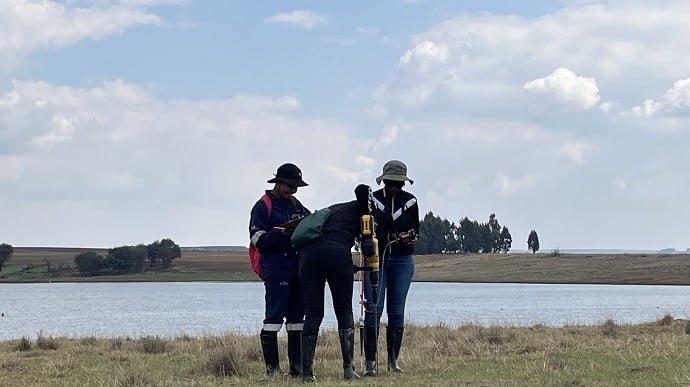Research by an international team of scientists led by the University of Pretoria’s (UP) Dr Jack Radcliffe has clarified the eating habits of massive black holes.
The team, which included astronomers Professors Peter Barthel (University of Groningen, Netherlands) and Professor Michael Garrett (University of Manchester, UK), concluded that central black hole growth can occur in many kinds of galaxies. “They feed themselves in various ways: some gobble as much as they can, others digest slowly, and others are starving for food.”
This research is important for multiple reasons: It is now well established that there’s an intimate link between the creation of new stars and the growth of the central black hole within the same galaxy. For this to occur, there must be some interaction or ‘feedback’ between the two. This comes in the form of bright radiation from the central black hole. This is a crucial area of research in astronomy, as the Universe we see today is dependent upon the interaction between these two processes. This research is important as it shows that new-generation radio telescopes, such as MeerKAT (in the Karoo desert, SA), will play a huge role in disentangling the link between these two processes.
“However, we show, rather controversially, that some of these objects will still remain indetectable in such studies and show, for the first time, that the radio jets – comprising of fast-moving particles travelling near the speed of light from the black hole and a crucial component of this ‘feedback’ mechanism – are optional,” said Dr Radcliffe.
A black hole is a region of space that is so dense that even light cannot escape. While most black holes are formed when massive stars die, the ones in the centre of galaxies (as seen by the black hole image of M87 by the Event Horizon Telescope) have been growing larger and larger over many billions of years by either merging with other black holes, or eating streams of gas and dust, much of which are ripped off stars.
The research was published as a series of two papers in the international journal Astronomy & Astrophysics. It entailed a systematic study of the occurrence and nature of nuclear activity in galaxies. The team investigated issues including: ‘Which types of galaxies do the central black holes start eating?’; ‘How does this manifest itself?’; and ‘What is the best way to detect these eating phases in galaxies?’.
Dr Radcliffe, a South African Radio Astronomy Observatory postdoctoral fellow, explained that, “Occasionally a growth phase occurs simultaneous with a star-formation phase, and is then difficult to detect. The nuclear growth process may or may not generate radio jets. Taken together, the absorption of matter onto the central black hole appears to be a standard ingredient in the life of a galaxy: black holes love food, but they eat in different ways.” He finished his PhD on this research in 2019, with professors Barthel and Garrett as his supervisors.
Occasionally an accretion or eating phase occurs simultaneously with stars being created which is then difficult to detect; the nuclear accretion process may or may not generate radio jets. These jets are important in the evolution of galaxies because they heat gas, which can then prevent stars from being formed. On the other hand, the same jets can also cause turbulence, which causes gas to collapse to form new stars. As a result, these jets can essentially regulate how many stars are formed.
“Observations with space telescopes have taught us a lot about active galaxies, but such telescopes are expensive,” Dr Radcliffe said. “We have shown that the radio telescopes of today and the coming decade, such as the Square Kilometre Array, based in SA and Australia, are optimally suited to study the eating habits of black holes in galaxies.”
According to professors Barthel and Garrett, “The evidence for massive black holes in the nuclei of all galaxies is now very strong. These black holes grow to their current mass, and it appears that our radio studies permit unique observations to address all aspects of the accretion processes, and to ultimately understand them.”
Galaxies are the building blocks of the universe. All galaxies, including the Milky Way, harbour supermassive black holes with masses millions or billions of times that of our own sun. Galaxies make stars continuously, from diffuse gas clumping together to form new stars, and occasionally during a short but rapid stellar birth wave. At the same time, supermassive black holes at the centre of galaxies grow, during relatively short phases, when they swallow matter from their immediate environment. These growth episodes manifest themselves as violent phenomena: emitting extremely strong radiation that we can then detect with our telescopes.
Astronomers have studied active galaxies since the 1950s, and gave them exotic names such as quasars, radio galaxies, and blazars. Decades of study with all kinds of telescopes on the ground and in space have yielded a good, but still not complete, picture of active galaxies.
The astronomers focused their study on a special part of the sky, the so-called GOODS-North field. That field, in size about one fifth of the area of the full moon, displays tens of thousands of faint distant galaxies, of which already quite a lot was known through studies with large optical telescopes as well as the Hubble, Spitzer and Chandra space telescopes.
Earlier, the team of astronomers used a transcontinental network of ultra-sensitive radio telescope to discover the active galaxies among all the galaxies in the field, and they published the results of that search in 2018. “Their suspicion that this technique is uniquely suited to detect nuclear activity in galaxies appeared true, but also demonstrated the existence of a class of active galaxies which are seemingly invisible to radio telescopes,” Dr Radcliffe said.
The publications ‘Nowhere to hide: radio-faint AGN in the GOODS-N field’ and ‘The radio emission from Active Galactic Nuclei’, by the astronomers J.F. Radcliffe, P.D. Barthel, M.A. Garrett, R.J. Beswick, A.P. Thomson, and T.W.B. Muxlow will appear this autumn in the international journal Astronomy & Astrophysics.
"Nowhere to Hide: Radio-faint AGN in the GOODS-N field". By: J.F. Radcliffe et al. Accepted for publication in Astronomy & Astrophysics.
Original: https://doi.org/10.1051/0004-6361/202038591
Free preprint: https://arxiv.org/abs/2103.08575v2
"The radio emission from Active Galactic Nuclei". By: J.F. Radcliffe et al. Accepted for publication in Astronomy & Astrophysics.
Original: www.aanda.org
Free preprint: https://arxiv.org/abs/2104.04519
Dr Jack Radcliffe
April 14, 2021

Dr Jack Radcliffe obtained a BSc degree and a master’s in Physics from Imperial College London in the UK (2010 to 2014). He went on to obtain a PhD in Astrophysics (2014 to 2019) jointly from the University of Manchester in the UK and the University of Groningen in the Netherlands.
Dr Radcliffe moved to South Africa in July 2019 to take up a postdoctoral appointment at the University of Pretoria (UP); the appointment was funded by the South African Radio Astronomy Observatory. In June 2021, he took up a permanent position as a lecturer at UP and as an honorary research fellow at the University of Manchester.
His research at UP has to do with the world-leading radio telescope MeerKAT, which South Africa developed and which will eventually transition into the Square Kilometre Array (SKA). This will be funded by 14 countries and will be one of the largest astronomy projects ever undertaken.
“It will revolutionise our understanding of many diverse areas of astrophysics,” Dr Radcliffe says. “In light of this, UP has undertaken an ambitious programme to build a research group, founded in 2018, that now comprises over 20 members.
“UP has decided to focus on a synergy between MeerKAT and other observatories through a technique called very long baseline interferometry (VLBI). This aligns well with my research. This is the same technique that has produced the two black hole images that propelled the UP astronomy group to world recognition. This growing national and global reputation of the University within the field of astronomy made doing research here an attractive prospect.”
Dr Radcliffe explains his long-held fascination with astronomy.
“Astronomy has always inspired awe and fascination, and has been influential in the time-old questions of why we are here and how we came to be. Astronomy could be thought of as ‘blue skies’ research, where seemingly billions of rands are injected into something without a real-world application. While this could draw anger from the public, the exacting standards that our instruments and rigorous analysis need to achieve our scientific goals mean that many offshoots and real-world applications are often borne from our research. The archetypal example of radio astronomy comes from Australia, where researchers at the Australian Commonwealth Scientific and Research Organisation developed the technology that was needed for WiFi to become possible.”
Dr Radcliffe is part of the astronomy group at UP and leads a sub-group that focuses on using VLBI to find and characterise the massive black holes within galaxies across the age of the universe. The group has active collaborations with many institutes across multiple continents.
“My own research at the moment involves technical aspects, such as how to make telescopes work better and more efficiently, and some scientific projects regarding how galaxies and their central supermassive black holes evolve over time.
“The astronomy group has been closely aligned with the Computational Intelligence Research Group (CIRG) within the Department of Computer Science at UP. The MeerKAT and SKA telescopes are making vast amounts of data that require intelligent solutions and cutting-edge algorithms to analyse. In particular, the use of machine learning and artificial intelligence technologies can assist here, hence the collaboration between the astronomy group and CIRG.”
A recent highlight for Dr Radcliffe was recognition the team received for their research on the eating habits of black holes in galaxies. They found that supermassive black holes have varying appetites and can consume a small or large amount of matter. It was featured on both national and international news stations.
Over the past 18 months, his research direction has changed to focus on the SKA. “In particular, I have focused on simulating how the telescope will operate. This will provide us with a way to test that the various systems are working properly, and we can extract science from day one, rather than finding out about issues later down the line.”
Dr Radcliffe says he found his way into academia to understand the unknown, and his dream is to make a lasting impact on our understanding of the cosmos.
“One of the big unsolved mysteries in astronomy at the moment is exactly how galaxies evolved to make the universe that we see today,” he says. “Every one of these galaxies have a supermassive black hole at the centre, and studies have shown that these grow with the galaxies and the stars within the galaxy. However, we are still unsure whether black holes influence the number of stars born and what mechanism causes this feedback loop. One of the main theories is that black holes emit streams of fast-moving particles (radio jets) that agitate the gas and so produce more stars. These streams of fast-moving particles are bright radio waves. I use telescopes to observe these radio waves to see how many black holes are emitting these streams of particles and their subsequent effect on the stars in the galaxies. This allows us to constrain theories of galaxy evolution and further our understanding of this process.”
Dr Radcliffe’s message to South African students in particular is that the future is very bright in astronomy.
“There are truly world-class facilities here, and these are only going to improve in the future with the advent of the SKA. South Africans can be expected to make a large proportion of amazing new discoveries in the future. For those who are undecided or would prefer to stay in industry, the skills that you get from doing an astronomy- or physics-related degree are highly attractive to many different industries. These skills include programming, problem-solving, statistics, high-performance computing and machine learning. In the modern age, almost every sector has a need for these sorts of skills.”
In his spare time, Dr Radcliffe is an avid player of many kinds of sport, including tennis, snooker, squash and golf. However, this has been curtailed by the recent arrival of his first-born, Archie.
 Story
Story
Scientists at the University of Pretoria (UP) are leading a study of natural hydrogen gas discovered under the Earth’s surface in Mpumalanga – a source of renewable energy that could contribute to the national energy budget and help address the energy shortage in South Africa.
 Infographic
Infographic
Hydrogen is considered a fuel of the future due to it emitting zero emissions. This infographic explains the impact of this discovery as well as some interesting facts about hydrogen and the different forms of it.
 Gallery
Gallery
Take a journey through some pictures from the field when UP scientists explored what lay beneath Mpumalanga's soil and rocks.
Copyright © University of Pretoria 2024. All rights reserved.
Get Social With Us
Download the UP Mobile App